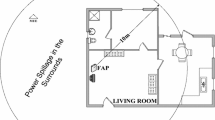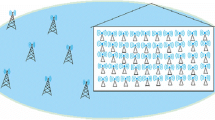Abstract
While femtocell networks represent a promising solution for extending high data-rate wireless services in indoor environments, despite their many benefits the short coverage distances involved can lead to frequent handovers being triggered resulting in overloading the macrocells. This handover problem is further exacerbated for users operating at the cell boundary. One solution is to keep the mobile station (MS) connected to the femtocell access points (FAP) by applying a handover bias to expand the femtocells coverage, though arbitrarily increasing the cell range can have a detrimental effect on system performance as the received interference will increase and may exceed tolerable levels. Many disparate factors including: FAP deployment density; resource constraints; and cell range expansion (CRE) influence the crucial interference-system performance nexus, and this was the motivation to analyse this relationship in order to facilitate successful FAP deployment. This paper critically analyses the impact of femtocell range expansion with a system-level simulation being undertaken for cooperative and non-cooperative resource allocation strategies. A new CRE framework for femtocell networks is then proposed, which takes cognisance of the interplay between key system parameters, with results confirming the cooperative model consistently outperforms the non-cooperative approach so affording enhanced system flexibility in terms of FAP range expansion.







Similar content being viewed by others
References
Valcarce, A., & Zhang, J. (2010). Empirical indoor-to-outdoor propagation model for residential areas at 0.9–3.5 GHz. IEEE Antennas and Wireless Propagation Letters, 9, 682–685.
Tariq, F., & Dooley, L. S. (2012). Cognitive femtocell networks. In D. Grace & H. Zhang (Eds.), Cognitive communications: Distributed artificial intelligence (DAI), regulatory policy and economics, implementation (pp. 359–394). Chichester: Wiley.
Zahir, T., Arshad, K., Nakata, A., & Moessner, K. (2013). Interference management in femtocells. IEEE Communications Surveys and Tutorials, 15(1), 293–311.
Andrews, J. G., Claussen, H., Dohler, M., Rangan, S., & Reed, M. C. (2012). Femtocells: Past, present and future. IEEE Journal on Selected Areas in Communications, 30(3), 497–508.
de Lima, C. H. M., Bennis, M., & Latva-aho, M. (2013). Statistical analysis of self-organizing networks with biased cell association and interference avoidance. IEEE Transactions on Vehicular Technology, 62(5), 1950–1961.
López-Pérez, D., Chu, X., & Guvenc, I. (2012). On the expanded region of picocells in heterogeneous networks. IEEE Journal of Selected Topics in Signal Processing, 6(3), 281–294.
López-Pérez, D., Guvenc, I., & Chu, X. (2012). Theoretical analysis of handover failure and ping-pong rates for heterogeneous networks. In ICC 2012 Workshop on small cell wireless networks (SmallNets). Canada: Ottawa. June 2012.
Ashraf, I., Claussen, H., & Ho, L. T. W. (2010). Distributed radio coverage optimization in enterprise femtocell networks. IEEE International Conference on Communications (ICC), May 2010 (pp. 1–6).
López-Pérez, D., Guvenc, I., de la Roche, G., Kountouris, M., Quek, T. Q. S., & Zhang, J. (2011). Enhanced intercell interference coordination challenges in heterogeneous networks. IEEE Wireless Communications Magazine, 18(3), 22–30.
Tariq, F., Dooley, L. S., & Poulton, A. S. (2013). Analysis of coverage range expansion in closed access cognitive femtocell networks. In 16th International symposium on wireless personal multimedia communications (WPMC); June 2013 (pp. 1–5).
Proakis, J. G., & Salehi, M. (2007). Digital Communications (5th ed.). New York: McGraw-Hill Higher Education.
de la Roche, G., Alayon-Glazunov, A., & Allen, B. (2012). LTE-advanced and next generation wireless networks: Channel modelling and propagation. UK: Wiley.
Tariq, F., Dooley, L. S., & Poulton, A. S. (2014). Interference aware virtual clustering paradigm for resource management in cognitive femtocell networks. Elsevier Computers and Electrical Engineering Journal, 40(2), 587–598.
http://www.3gpp.org/LTE. Accessed on January 17, 2013.
Kysti, P. et al. (2007). WINNER II channel models. ver 1.1, September 2007. https://www.ist-winner.org/WINNER2-Deliverables/D1.1.2v1.1.pdf. Accessed on January 17, 2013.
Author information
Authors and Affiliations
Corresponding author
Rights and permissions
About this article
Cite this article
Tariq, F., Dooley, L., Allen, B. et al. A Cell Range Expansion Framework for Closed Access Femtocell Networks. Wireless Pers Commun 93, 601–614 (2017). https://doi.org/10.1007/s11277-014-2216-y
Published:
Issue Date:
DOI: https://doi.org/10.1007/s11277-014-2216-y




